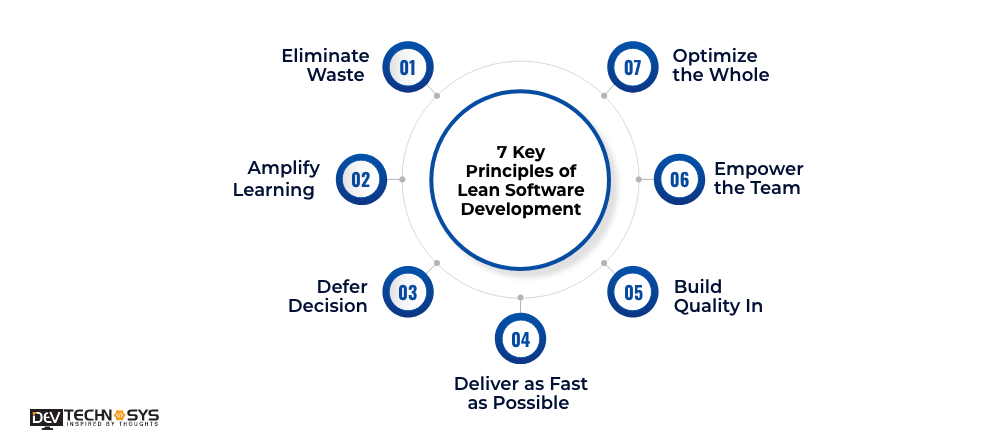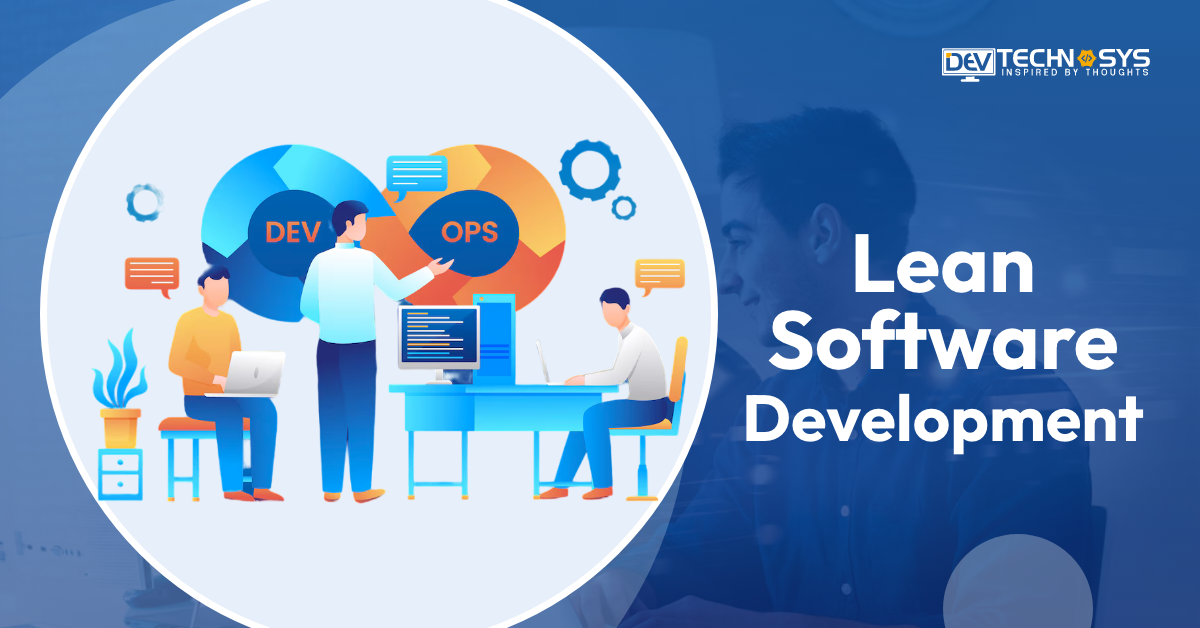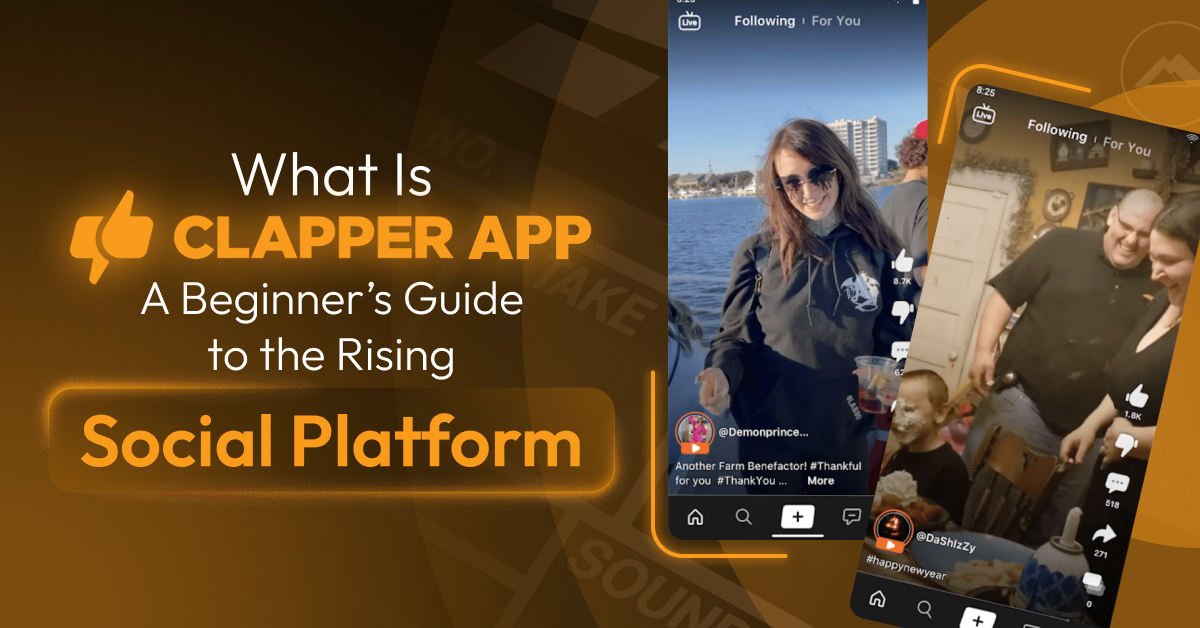What if you can streamline the software development process, saving resources and time while developing high-quality results? Well, if you want this, lean software development is the best option. By maximizing customer value and eliminating waste, this approach allows businesses to work more effectively and efficiently.
Investment in lean software development leads to improved collaboration, improved productivity, and, ultimately, better outcomes for a business. Hence, this depicts the significance of lean software development in business growth.
So, if you also want to create lean software, read this blog till the end. This will explore how you can develop successful lean software aligning with your business goals.
Quick Summary: This blog has covered everything you need to know about lean software development, including alternatives, costs, features, benefits, principles, and more. So, let’s start!
Introduction of the Lean Software
Do you know what is lean in software development? The answer is that lean is a software development methodologies inspired by lean manufacturing principles. It’s an agile framework that optimizes development processes and time, eliminates waste, and delivers only what the product needs.
It practices creating new features and then iteratively adding on-based feedback. Lean agile software development promotes iterative progress, continuous improvements, and customer feedback integration through the development procedure. A lean system keeps projects adaptable and responsive to changing needs by working in short cycles and embracing continuous improvements.
Top 5 Lean Tools
If you are considering lean manufacturing software development, you must study lean tools. It wil help you to understand where each one will have a major impact. If you know about this, it’s good; however, if you are not familiar with this, look here:
- 5S
- Kaizen
- Value Stream Mapping
- Defect Tracking Software
- Plan-Do-Check-act (PDCA)
1. 5S
It’s a Japanese term that stands for Sort, Straighten, Shine, Standardize, and Sustain, which promotes an organized and clean work environment. In software development, the lean tool means keeping code well-documented, clean, and easy to navigate.
2. Kaizen
It’s another Japanese term that means “continuous improvement. As per this Lean Principle, software tools must allow for easy iteration and code adaptation based on feedback and testing.
3. Value Stream Mapping
This lean tool assists in visualizing the entire process of custom software development services, from initial concept to launch. By identifying challenges and non-value-added activities, businesses can streamline the process.
4. Defect Tracking Software
As you know, errors and bugs are inevitable; lean emphasizes early detection and resolution. Lean software integrates seamlessly with a defect-tracking system to successfully record, prioritize, and fix issues.
5. Plan-Do-Check-act (PDCA)
It’s a four-step method for creating and carrying out changes in the workplace. Lean software should support defining improvements plans (Plan), implementing changes (Do), monitoring results (Check), and adapting based on findings (Act).
7 Key Principles of Lean Software Development
The lean development methodology is based on the same principles used for manufacturing. However, as per the manufacturing software development company, implementation of these principles will be different. Let’s take a closer look at these principles and how they are implemented differently:
- Eliminate waste
- Amplify learning
- Defer Decision
- Deliver as Fast as Possible
- Build Quality In
- Empower the Team
- Optimize the Whole

1. Eliminate Waste
Lean software development is designed to remove waste which is defined as processing activity, adding no value to the end product delivery. In software development, waste could be fixing bugs caused by rushed work, features of no use, and endless meetings that do not lead to decisions. As per this principle, identify and get rid of these things to focus on what matters to targeted users.
2. Amplify learning
This principle prioritizes knowledge created throughout the workflow, which is significant for ensuring customer satisfaction. This could involve sharing knowledge through teamwork, having sessions to discuss new ideas, and simply getting feedback from users early and often. With the team’s learning, the software becomes better.
3. Defer Decision
This principle says waiting until the last responsible moment to make a decision. As per this principle, it’s’ okay to wait on some important decisions until you have more information.
In software development, this means not finalizing every detail at the beginning. Instead, businesses must focus on the core design and make adjustments as they learn more about what target users need and what works best.
4. Deliver as Fast as Possible
This lean software principle concerns improving marketing performance with minimum viable product development instead of a fully effective system.
This principle says that speed is more important, however, do not compromise with quality. Lean focuses on delivering working features to users as soon as possible. This enables businesses to get honest feedback early and adjust accordingly.
5. Build Quality In
Quality is key! Lean focus on writing clean, well-tested code from the initial, instead of fixing a bunch of glitches or bugs later. This act uses strong bricks and has a good function when making use of them.
It consumes much time upfront; however, you end up with a high-quality product in the long run. Overall, the goal is to ensure that a program solution is routinely reviewed.
6. Empower the Team
Unlike standard software development approaches and Akins’s approach to Agile software development, this approach empowers instead of directs developing teams.
Value your team environment where all feel engaged and empowered to participate in decision-making. This means giving developers ownership of their work and encouraging them to speak up about their concerns or new ideas.
7. Optimize the Whole
This final principle enables businesses to find useful solutions by evaluating the effectiveness of an entire system rather than just individual components.
This holistic approach involves understanding how different parts of the process interact and finding ways to streamline the entire workflow. Value stream mapping and system thinking are useful tools for identifying hurdles and optimizing the entire process.
5 Benefits of Developing Lean Software
Lean software is not just a craze or trend; it’s a philosophy that can potentially change how software is developed. By shifting focus to efficiency and eliminating waste, lean practices lead to a happier team, more satisfied clients, and high-quality products. If you want to know more about how lean software development can be beneficial for your business, look here:

- Improved Focus and Clarity
- Enhance Customer Satisfaction
- Reduced Costs
- Eliminate Waste
- Increased Agility and Adaptability
1. Improved Focus and Clarity
Lean principles encourage effective communication and well-defined goals within the team. Hence, this eliminates wasted efforts and confusion and allows businesses to stay focused on delivering the core functions that bring value to the businesses.
2. Enhance Customer Satisfaction
Iterative development and frequent user feedback ensure that the lean software continuously changes to meet real users’ needs. This results in a product that users find valuable and enjoy using. Hence, it fosters high customer satisfaction and loyalty.
3. Reduced Costs
If you develop lean software, you eliminate waste in processes and features. This also minimizes resource allocation and development time, significantly saving costs. Moreover, focusing on features that potential user’s value reduces the risk of investing in unused functionalities.
4. Eliminate Waste
Lean identifies and removes activities that don’t add value. These can range from excessive code to unclear requirements. By streamlining processes, businesses can focus on what actually matters: delivering a valuable product. For enterprise mobility solutions, eliminating waste means faster development cycles and more effective software deployment.
5. Increased Agility and Adaptability
The iterative nature of lean development makes it easy for businesses to adapt to evolving market demand or customer requirements. The focus on developing minimum viable features allows for quick adjustments and course corrections as required.
When we were looking for lean software development, Dev Technosys was an indispensable partner in our journey. Their experience and dedication to lean software development principles have streamlined our process, improved efficiency, and delivered exceptional results. We highly recommend Dev Technosys for anyone looking for a reliable and innovative software solution.
John Smith
7 Key Steps to Develop Lean Software
Now that you have discussed the concept and benefits of lean software, it’s time to discuss the lean management software development life cycle, which you came here to learn about.
- Validate Idea Before Development
- Appropriate Tech Stack
- Design for Usability (UI/UX)
- Develop the software
- Testing and Quality Assurance
- Launching and Marketing
- Provide Continuous Support and Updates

1. Validate Idea Before Development
Before developing lean software, you must validate your idea to clarify its purpose. Market research is significant, but lean emphasizes validating assumptions early and often. We advise you to conduct user research to understand their needs and then build an MVP (minimum viable product).
It’s a version of your lean software with significant features to attract early adopters. To iterate and refine the concept before extensive development, collect user feedback on the version.
2. Appropriate Tech Stack
Now you have to make an important decision regarding selecting the tech that contributes to the app’s success. While choosing the most suited tech stack for your business, avoid over-engineering. Ensure that you select scalable, efficient technologies, and meet your app’s specific needs.
If you choose a complex framework, it might create unnecessary complexity for your app. Hence, you can get help from a software product development company to help you make an informed decision.
3. Design For Usability (UI/UX)
An intuitive and clear UI/UX is critical for user adoption. According to lean principles, you must focus on core functionalities and delivering user value. With a user-centered design, you can ensure your lean software is functional and enjoyable to use.
Moreover, a well-designed interface reduces user frustration and leads to faster adoption. Also, user feedback from MVPs should be considered, and interactions should be designed based on this to ensure a seamless user experience.
4. Develop the Software
Now that you have a validated idea, a suitable technology stack, and a user-centric design, you can begin lean software development. You can build and deliver features in small and testable increments with iterative development.
This allows for continuous feedback and instant correction through the procedure. Additionally, you can hire software developers who can ensure scalability, performance, and security.
5. Testing and Quality Assurance
It’s the most significant stage of the entire lean agile software development process, where testing and quality assurance play a critical role. However, lean promotes preventing defective forms from starting.
Software testing services involve writing a unit test to verify individuals’ code elements function well, as well as integration testing that ensures different parts of the lean software work seamlessly together. Automated testing tools can streamline this process, saving time, resources, and cost.
6. Launching and Marketing
Finally, the development process is complete, and everything has been checked. Now, you can introduce your lean software to the world. If you want to capture a big audience, create effective marketing strategies to create a buzz.
You can use social media, email campaigns, and many other tools. Leveraging the feedback collected during enterprise product development services, you can tailor your marketing messages to resonate with the target audience.
7. Provide Continuous Support and Updates
Now that you have successfully launched your software, your work is not over here. Still, you are responsible for maintaining your app continuously. Monitor your software so that new glitches, bugs, and other issues can be instantly identified and resolved.
Furthermore, to remain competitive, analyze the market trends and add new features based on them. It will keep users engaged and retained for the long term.
Must-have Features of Lean Software
Do you know why so many businesses face failure, even if they have well-designed software? This is because they are unable to choose the right features. That is the key to software success. So, this blog section is going to cover some unique and significant features that will help you enjoy success in the industry.

1. Simple and Intuitive Interface:
Simplicity is king. So, an intuitive interface in lean software cuts through the clutter, enabling businesses to focus on tasks.
2. Automated Workflow:
This feature frees up the employees, which allows them to tackle more strategic initiatives.
3. Rotating Wall Boards:
It keeps everyone on the same page, allowing the team to track progress, identify hurdles, and celebrate accomplishments in real-time.
4. Payment Integration:
This feature focuses on providing custom payments software development solutions, ensuring seamless transactions and enhanced users experience.
5. Access Via the Cloud:
Accessibility from anywhere fosters collaboration. Updates and data are readily available to keep everyone in sync.
6. Documentation:
Comprehensive documentation acts as a central source of veracity. It reduces errors, simplifies onboarding, and ensures consistent practices.
7. Activity Report:
This feature offers thorough analysis of team advancement and user actions. This collected data helps in making informed decisions.
8. Customizable Dashboards:
Build lean software that allows users to customize the dashboard to display information based on their requirements.
9. Analytics and Reporting:
Robust analytics and reporting capabilities provide significant information about user behavior and system performance, helping implement data-driven changes.
10. Security:
Sophisticated security measures ensure software integrity and safeguard sensitive data. This promotes a safe environment for development and increases trust.
Cost Analysis to Lean Software Development
When it comes to building lean software, only one thing makes investors hold their idea: the cost. So, if you are also concerned about the lean software development cost, you have to understand that no specific digit defines the overall cost.
The cost depends on various factors such as app, design, features, development team, functionality, etc. Hence, on average, you can estimate $8000 to $28000 as the overall custom software development cost.
The given table will help you understand how the level of your lean software’s complexity can fluctuate the cost:
Lean Project Management Software |
Estimated Cost |
Time Frame |
|
Simple Lean Project Management Software Development |
$8000 – $14000 | 3 to 6 Months |
|
Medium-Complex Lean Project Management Software Development |
$14000 – $20000 | 6 to 9 Months |
|
High-Complex Lean Project Management Software Development |
$28000+ | 10+ Months |
Tech Stack For Lean Software Development
There is no one-size-fits-all tech stack for lean agile software development. However, you can consider the given table to develop your own leans software:
- Simplicity: Opt for well-established, easy-to-learn tools
- Flexibility: Select technologies that adapt to evolving requirements
- Fast feedback: Choose a tool that enables rapid iteration and testing
Layer |
Technology |
Focus |
|
Frontend |
JavaScript (React/Vue.js) |
Interactive elements, user interface |
| Backend | Python (Django/Flask) | Data processing, server-side logic |
| Database | NoSQL (MongoDB) | Flexible data storage for rapid prototyping |
|
Version Control |
Git | Version tracking and collaboration |
|
Testing |
Unit Testing Frameworks |
Ensure code quality and functionality |
|
Deployment |
Cloud Platforms (AWS/Azure) | Scalable infrastructure for easy deployment |
Wrapping Up!
Hopefully, this blog will help you understand how lean software development can be a game-changer for businesses looking to optimize own software development processes.
By prioritizing customer values and minimizing waste, businesses can work efficiently and deliver high-quality results. Investment in such software development can lead to improved collaboration and increased productivity and ensure better business outcomes.
So, if you want to make lean software, you can get assistance from a web development company. You can consult with Dev Technosys. As a reputed and experienced software development company, Dev Technosys has delivered thousands of high-quality projects.
So what are you waiting for? Connect with us, and let us help you meet your business goal.
Frequently Asked Questions
1. What is Lean Programming
Lean programming basically refers to two things:
- Lean Software Development: Optimizing software creation by reducing waste and focusing on value for the users.
- Lean Programming Language: A system for writing code with a focus on correctness and maintainability
2. How Much Does It Cost to Lean Software Development?
On average, lean agile software development costs between $8000 to $28000. However, due to the following factors, costs can fluctuate:
- Project complexity
- Team size and experience
- Development tools and technologies used
3. How Long Does It Take to Lean Software Development?
The timeline for lean agile software development depends on the desired features and functionality. On average, the time can be 3 to 10 months. However, if you want to develop more complex software, the time can be extended by one year.
4. How Can I Measure the Success of Lean Implementation?
- Look for improvements in team collaboration and communication
- Track key metrics include defect rates, lead time, and customer satisfaction.
- Measure the value delivered to customer compared to your development efforts.
5. Does Lean Work for All Software Projects
- Lean principles can be applied to different software projects; however, spending may require adjustment based on the projects’ complexity and size.
- The software is well-suited for a project focusing on rapid iteration and value delivery.






























